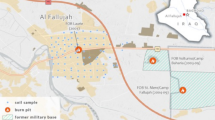Abstract
Pollution due to ashes spilt out into forest roads has been identified. This source influences the analytes concentrations in soil in their close vicinity. The anomaly was discovered during the biomonitoring tests conducted in the area of Bory Stobrawskie (southern Poland). Samples of Pleurozium schreberi moss and soil collected near the road showed higher values of macro- and microelements in comparison with other samples collected within the monitored area. A total of 41 elements was determined: 38 using instrumental neutron activation analysis (INAA) and 3 using atomic absorption spectrometry (AAS). It has been demonstrated that the analytes concentration in ashes is several to a dozen or so times even higher than mean concentrations determined in soil samples collected at a distance of 5 to 30 km from the road (pollution source). In mosses growing near the road covered with ash, increased concentration of the following elements has been determined: Mg, Al, Cl, Ca, Sc, V, Mn, Fe, Zn, As, Se, Br, Cd, I, La, Dy, Yb, Ta and Th, which could gives evidence to the presence of bioavailable forms of these elements. This anomaly could lead to erroneous assessment of deposition of pollutants created by emitters long apart.




Similar content being viewed by others
References
Conti, M. E., & Cecchetti, G. (2001). Biological monitoring: lichens as bioindicators of air pollution assessment—a review. Environmental Pollution, 114, 471–492.
Freitas, M. C., Reis, M. A., Marques, A. P., Almeida, S. M., Farinha, M. M., de Oliveira, O., et al. (2003). Monitoring of environmental contaminants: 10 years of application of k0-INAA. Journal of Radioanalytical and Nuclear Chemistry, 257(3), 621–625.
Frontasyeva, M. V., Nazarov, V. M., Grass, F., & Steinnes, E. (1995). Intercomparison of moss reference material by different multi-element techniques. Journal of Radioanalytical and Nuclear Chemistry, 192(2), 371–379.
Frontasyeva, M. V., & Pavlov, S. S. (2000). Analytical Investigations at the IBR-2 Reactor in Dubna, JINR Preprint, E14-2000-177, Dubna.
Frontasyeva, M. V., Smirnov I, L., Steinnes, E., Lyapunov, S. M., & Cherchintsev, V. D. (2004). Heavy metal atmospheric deposition study in the South Ural Mountains. Journal of Radioanalytical and Nuclear Chemistry, 259(1), 19–26.
Grodzińska, K., Frontasyeva, M., Szarek-Łukaszewska, M., Klich, M., Kucharska-Fabiś, A., Gundorina, S. F., et al. (2004). Trace element contamination in industrial regions of Poland studied by moss monitoring. Environmental Monitoring and Assessment, 87(3), 255–270.
Kłos, A., Rajfur, M., Wacławek, M., & Wacławek, W. (2005a). Ion equilibrium in lichen surrounding. Bioelectrochemistry, 66, 95–103.
Kłos, A., Rajfur, M., Wacławek, W., & Wacławek, M. (2005b). Influence of abiotic factors on heavy metal sorption in lichens. Annals of the Polish Chemical Society, 2, 173–176.
Ostrovnaya, T. M., Nefedyeva, L. S., Nazarov V. M., Borzakov, S. B., & Strelkova, L. P. (1993). In: Activation Analysis in Environment Protection, D-14-93-325, Dubna, p. 319.
Seaward, M. R. D. (2006). Biomonitors of environmental pollution: an appraisal of their effectiveness. Ecological Chemistry and Engineering, 13(3–4), 193–199.
Szarek-Łukaszewska, M., Grodzińska, K., & Braniewski, S. (2002). Heavymetal concentration in themoss Pleurozium schreberi in the Niepołomice Forest, Poland: changes during 20 years. Environmental Monitoring and Assessment, 79(3), 231–237.
Szczepaniak, K., Astel, L., Simeonov, V., Tsakovski, S., Biziuk, M., Bode, P., et al. (2007). Comparison of dry and living Sphagnum palustre moss samples in determining their biocumulative capability as biomonitoring tools. Journal of environmental science and health. Part A, Toxic/hazardous substances & environmental engineering, 42(8), 1101–1115.
Wolterbeek, B. (2003). Biomonitoring of trace element air pollution: principles, possibilities and perspectives. Proceedings of the Internacional Workshop in Biomonitoring of atmospheric pollution (with emphasis on trace elements)—BioMAP II, 28 August–3 September 2000, IAEA-TECDOC-1338, pp. 87–104.
Zechmeister, H. G., Hagendorfer, H., Hohenwallner, D., Hanus-Illnar, A., & Riss, A. (2006). Analyses of platinum group elements in mosses as indicators of road traffic emissions in Austria. Atmospheric Environment, 40, 7720–7732.
Author information
Authors and Affiliations
Corresponding author
Rights and permissions
About this article
Cite this article
Kłos, A., Rajfur, M., Wacławek, M. et al. The Influence of Unidentified Pollution Sources on the Irregularity of Biomonitoring Tests Results. Water Air Soil Pollut 191, 345–352 (2008). https://doi.org/10.1007/s11270-008-9629-8
Received:
Accepted:
Published:
Issue Date:
DOI: https://doi.org/10.1007/s11270-008-9629-8




